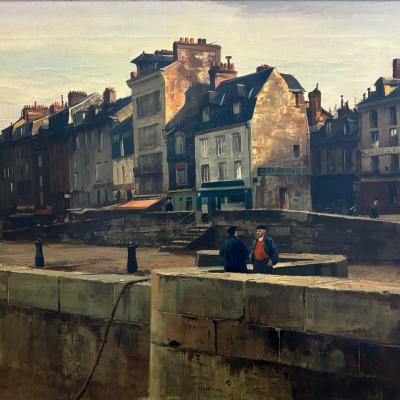artist
Pleissner was born on April 29, 1905, in Brooklyn, New York, to musically inclined parents. At age eleven, a friend gifted him a paintbox, sparking his lifelong passion for art. As a child, he spent several summers in Wyoming, where he sketched from life and developed a deep appreciation for the outdoors, fishing, and the Western landscape.
He attended the Art Students League of New York from 1922 to 1926, studying under Frank DuMond. Shortly after, he began teaching at the Pratt Institute. In the 1930s, Pleissner primarily worked in oils, earning recognition for his Western landscapes as well as his depictions of the Maritimes and New England. In 1938, the National Academy of Design awarded him the Second Hallgarten Prize for South Pass City (Wyoming Ghost Town).
At the outset of World War II, Pleissner was commissioned as a captain in the United States Air Force and stationed in the Aleutian Islands as a war artist. The harsh, damp conditions of the region forced him to work primarily in watercolors, as they dried more quickly than oils. In 1942, Pleissner accepted a commission from the U.S. Army as a war correspondent on inactive duty, employed by Life magazine. After the war, he continued to travel across Europe and Wyoming, painting city scenes, landscapes, and sporting subjects.
Pleissner also served as the director and trustee of the Tiffany Foundation. He died in 1983 in London, England.
Description
Pleissner transforms a simple riverside street into a scene of quiet grandeur. The architecture reflects the historic charm of the region—stucco façades, slate roofs, and modest shops with signs that are either faded or intentionally left illegible. This choice directs the viewer’s attention away from specific details and toward the overall tone and rhythm of the scene. Figures are scattered along the street, some strolling, others paused in conversation, all contributing to a sense of unhurried daily life.
What sets Normandie apart is Pleissner’s masterful use of light. The sun sits low—either rising or setting—and bathes the buildings of this postwar French village in a warm, golden glow, highlighting their textures and architectural nuances. Long shadows stretch across the foreground, casting it in darker tones that contrast with the sunlit façades behind. This raking light lends the composition both depth and a contemplative stillness. The mood is tranquil, almost nostalgic, evoking a moment of transition—between times of day, and perhaps even between eras. With the sensitivity of both a fine artist and a former war correspondent*, Pleissner elevates the ordinary, rendering this humble townscape a luminous study in place, time, and memory.
*During World War II, Pleissner served as an official war artist for the U.S. Army Air Forces, beginning in 1942. His role was to document military life and combat zones through on-the-ground observation and artwork, producing images that would serve both as records and morale boosters.


















